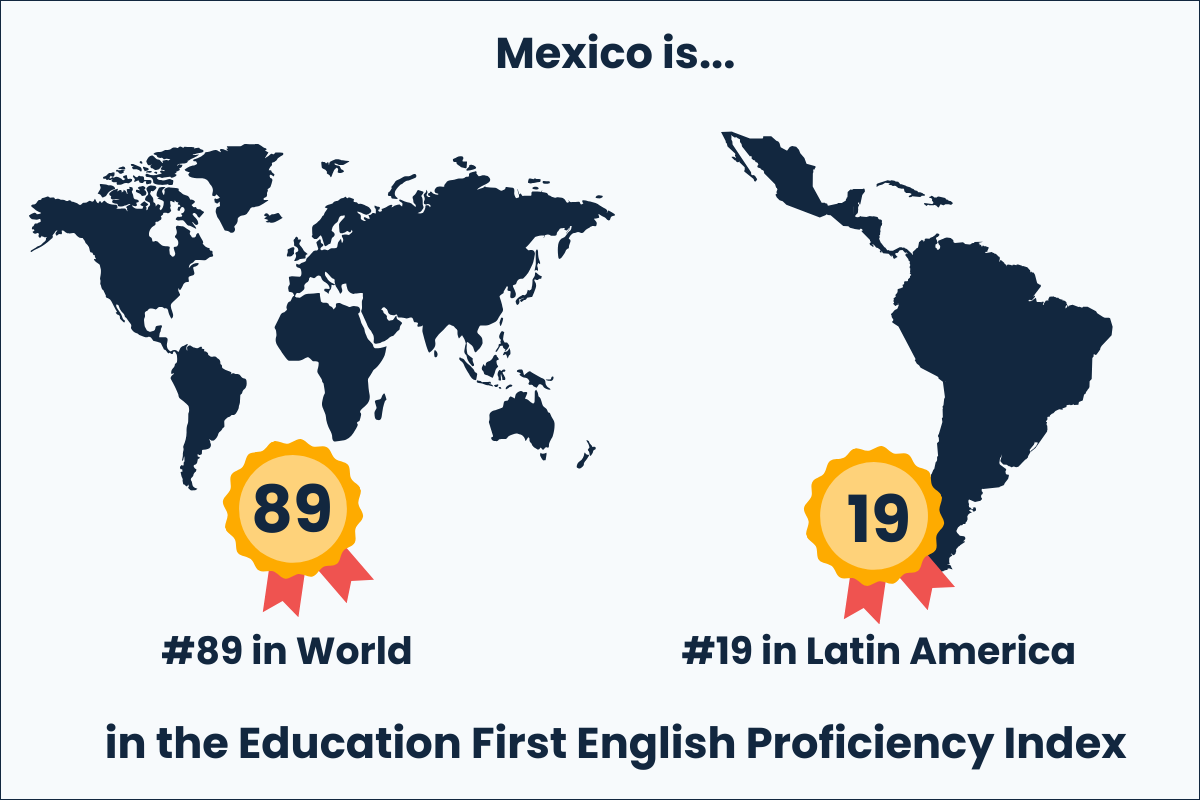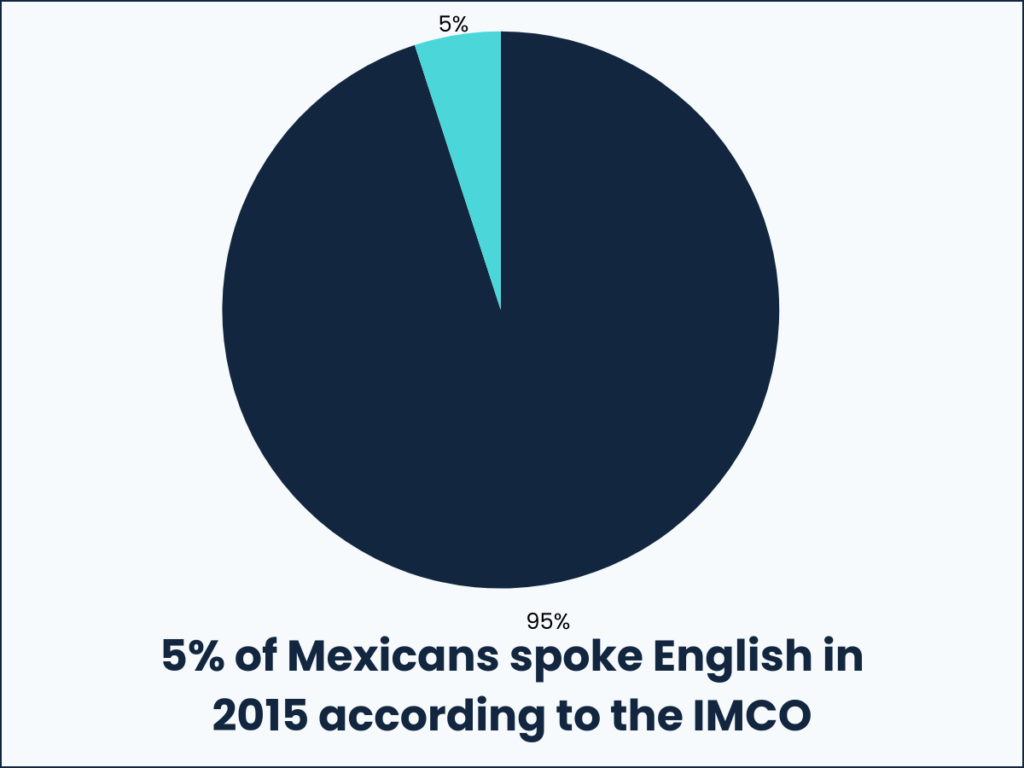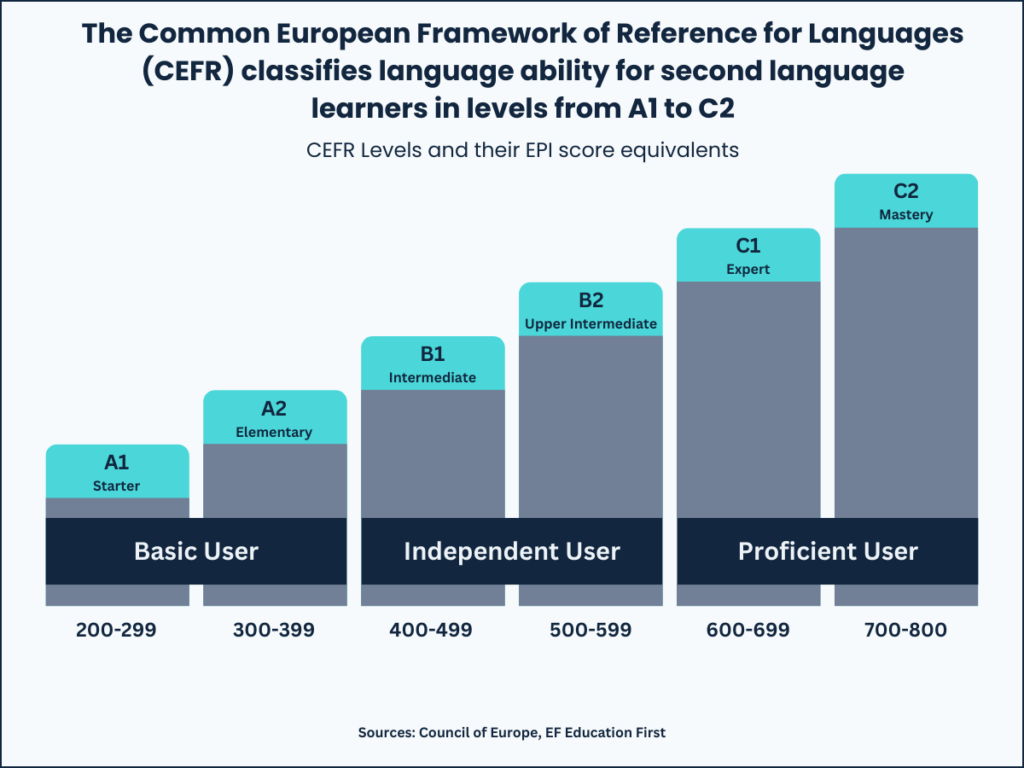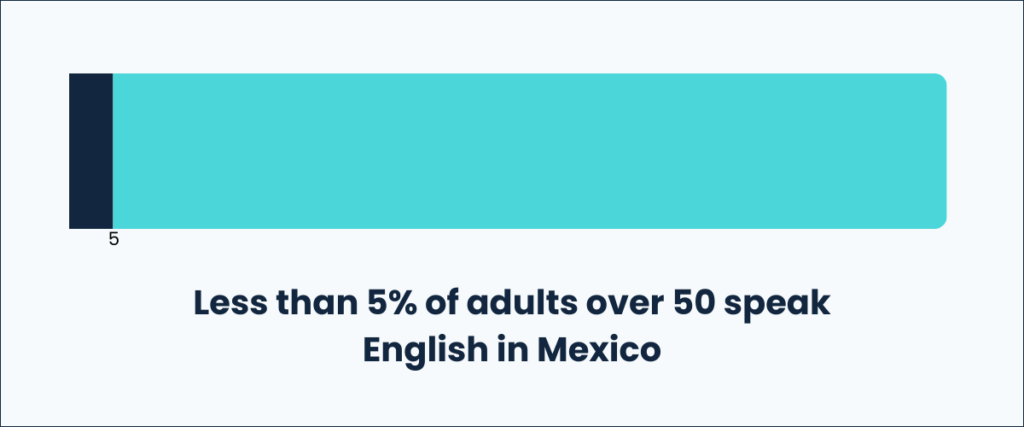How Many People in Mexico Speak English?

There are over 60 languages spoken in Mexico, including Spanish and indigenous languages. The country has no official language, but the national language is Spanish, with roughly 99% of the population (approximately 126 million people) speaking it as either their first or second language.
These figures make Mexico the country with the most native speakers among Spanish-speaking countries. The second most widely-spoken language in the country is English, followed by Nahuatl and other indigenous languages spoken by minority groups.

Despite being the second most widely-spoken language in the country, speaking English is still not common. By all estimates, only a small share of Mexico speaks English, and even fewer people claim to be highly proficient. The country ranked #89 out of 113 countries in terms of English proficiency in 2023.
According to a 2015 analysis done by the Mexican Institute for Competitiveness (IMCO), the total population of English-speaking people in Mexico was estimated at 5%, roughly 6 million people at the time.
However, these numbers only tell half the story, as attitudes towards the English language have changed drastically over the past two decades. Keep reading for an in-depth coverage of Mexico’s English language statistics and trends!
Number of English Speakers in Mexico (General Stats)
According to the data, most people in Mexico don’t speak English. The general English language skills appear low. Here are some general stats to paint a clearer picture:
- Only 5% (roughly 6 million people) of Mexico’s population speaks English, according to 2015 estimates.
- A 2013 survey conducted by the Mitofsky agency found that over 50% of respondents who claim to know English rate their reading and speaking skills as “bad” or “very bad.” Only 8.8% claimed to speak the language very well.
- Mexico ranks #89 out of 113 countries for English skills, according to English Proficiency Index (EPI) data published in 2023 on the Education First website.
- Mexico has an average EPI score of 451, which is 51 points below the global average.
- Mexico is second to last in Latin America for its English skills. It scored 30 points over Haiti but more than 100 points below Argentina.
- The EPI index ranks English proficiency in Mexico as low, though scores vary drastically between different regions and cities.
- The cities with the best English scores in 2023 were Guadalajara, Monterrey, León, and Hermosillo.
- The best English-speaking regions were Jalisco, Nuevo Leon, Queretaro, and Michoacan.
- The Mexican government started introducing English in 4th-grade classrooms in 2001. Previously, English was a mandatory subject only in grades 7 through 9.
- In 2009, the Ministry of Education introduced “Programa Nacional de Inglés en Educación Básica,” a national program that would make English a mandatory school subject starting in primary school.
- 23.9 million people or 21% of the population were learning English in 2015, according to a study done by the British Council.
It’s worth mentioning that other articles on the subject cite larger figures for English speakers, usually 12% of the population. This number comes from a 2013 survey conducted by the Misofsky agency, which had a population sample of 1000 people over 18 years old.
While such surveys have their limitations, the study offers an interesting insight into the evolution of English language trends:
- The percentage of adults speaking a foreign language rose from 8.6% to 12.9% between 2007 and 2013.
- Of those 12.9%, 92% claimed to know English (11.6% of the population).
- English speakers were more likely to live in urban areas, especially in Northern or Central Mexico.
- 1 in 3 people with a university degree spoke English, considerably more than those with just secondary education (11%) or primary education (<3%).
- People under 30 were most likely to speak English.
Whether English speakers make up 5% or 12% of the population, the overall number is still extremely low. Multiple factors contribute to this, including the late introduction of mandatory English education in schools, inefficient teaching practices, and cultural attitudes.
For a long time, speaking fluent English was not seen as necessary in Mexico. Indeed, the Spanish language remains one of the most important languages in the world. It’s the second most commonly spoken mother tongue globally, and the fourth largest language by total speakers.
As a result, English wasn’t seen as a crucial part of the school curriculum, unlike in other parts of the world. But just speaking Spanish is no longer enough in an increasingly competitive global market, where English-speaking countries are at a massive advantage.
The impact of English as the primary language of business is undeniable and people have been taking note of this. The number of new English speakers and learners has been increasing over the past two decades thanks to efforts made by Mexico’s government to promote English in schools.

Mexicans have started showing more interest in learning the language, especially the younger generations. In 2013, Mexico was the 18th largest ELT (English Language Teaching) market worldwide, having registered a 35% increase in students since 2011.
Learning English ensures better jobs and international study opportunities. Those fluent in English can earn 28-50% more than those who don’t speak the language. And the number of employers who are looking for English speakers is also on the rise.
According to Arleth Leal, associate director of the Red Ring recruitment firm, 70% of job vacancies posted by the company require English. This is especially true for industries like tech, administration, finance, or management.
Sources: Chron, Consulta Mitofsky, ICEF, Education First, ERIC, Expansion, El Financiero
English Speakers in Mexico by Region
The 2013 Mitofsky survey looked at English speakers in four geographical regions— Northern Mexico, the Bajio, Central Mexico, and Southeastern Mexico. Northern Mexico had the largest share of English speakers in the country. More than 1 in 5 surveyed adults said they speak English.
Considering this, the Mexican states with the most English speakers are likely going to be:
- Sonora
- Sinaloa
- Nuevo Leon
Central Mexico came in second; 12.9% of adults in the region spoke English, according to the survey. Just under 4-5% of respondents in the Bajio and southeast claimed to know English.
The English skills can vary considerably from one state to another, even within the regions with the most English speakers. Here’s what the latest English proficiency data from EF shows:
| State | EPI Score (Out of 800) | Proficiency Level |
| Jalisco | 538 | Moderate |
| Nuevo Leon | 531 | Moderate |
| Queretaro | 519 | Moderate |
| Michoacan | 519 | Moderate |
| Morelos | 518 | Moderate |
| Colima | 516 | Moderate |
| Sonora | 508 | Moderate |
| Sinaloa | 506 | Moderate |
| Guanajuato | 505 | Moderate |
| Zacatecas | 498 | Low |
| Aguascalientes | 492 | Low |
| Nayarit | 486 | Low |
| San Luis Potosi | 485 | Low |
| Baja California Sur | 480 | Low |
| Tabasco | 478 | Low |
| Quintana Roo | 476 | Low |
| Campeche | 458 | Low |
| Durango | 457 | Low |
| Guerrero | 444 | Very Low |
| Yucatan | 438 | Very Low |
| Tamaulipas | 437 | Very Low |
| Tlaxcala | 435 | Very Low |
| Puebla | 435 | Very Low |
| Veracruz | 433 | Very Low |
| Chihuahua | 432 | Very Low |
| Estado de México | 428 | Very Low |
| Hidalgo | 422 | Very Low |
| Baja California | 413 | Very Low |
| Oaxaca | 405 | Very Low |
| Chiapas | 391 | Very Low |
| Coahuila | 365 | Very Low |
The regions with the best English skills were located either in Northern or Central Mexico. However, despite having the most English speakers in the country, Northern Mexico also has a few regions with very low scores. In Coahuila, for example, test takers had the equivalent of an A2 (elementary) level in English.

The Mexican states that have the most and the best English speakers are:
- Sonora
- Sinaloa
- Nuevo Leon
- Jalisco
- Colima
- Michoacan
Overall, the most and the best English speakers in the country are likely to be in the regions closest to the U.S. border in the North, and near the capital of Mexico City in Central and Central West Mexico.
Those with scores between 500-599 have the equivalent of a B2 level in English, which is often described as upper-intermediate. People with scores between 400-499 speak English at a B1 (intermediate) level.
Sources: Consulta Mitofsky, Education First 1 & 2
English Speakers in Mexico by City
The Mexican cities with the most speakers are in Northern and Central Mexico. Urban centers with large populations and big local economies are the most likely to attract English speakers on the lookout for better work and education opportunities.
Cities most visited by tourists are also likely to have a sizable population of English speakers. The most popular tourist areas are always on the lookout for employers who can speak English with their clients. Not to mention that some of the most attractive tourist destinations in the country are a second home for many U.S. expats living in Mexico.
With that in mind, the Mexican cities with the most English speakers are:
- Mexico City
- Guadalajara
- Monterrey
- Cancun
- Puerto Vallarta
- San Miguel de Allende
- Puebla
Many of these cities are home to American international schools, providing private bilingual education to Mexican students. Examples include the Westhill Institute and the Alliant International University in Mexico City, the International American School of Cancun, and the American School Foundation (with campuses in Mexico City, Monterrey, Puebla, and Guadalajara).

In terms of proficiency, the cities with the best English skills in 2023 were those from the Northern and Central states:
- Guadalajara
- Monterrey
- León
- Hermosillo
Here’s a full breakdown of the scores for some of Mexico’s most important cities:
| City | EPI Score (Out of 800) | Proficiency Level |
| Guadalajara | 547 | Moderate |
| Monterrey | 545 | Moderate |
| León | 535 | Moderate |
| Hermosillo | 531 | Moderate |
| Cuernavaca | 524 | Moderate |
| Morelia | 522 | Moderate |
| Santiago de Queretaro | 518 | Moderate |
| Chihuahua City | 516 | Moderate |
| Ensenada | 512 | Moderate |
| Culiacan | 509 | Moderate |
| San Luis Potosí | 501 | Moderate |
| Reynosa | 499 | Low |
| Aguascalientes | 492 | Low |
| Mexicali | 477 | Low |
| Cancún | 467 | Low |
| Mexico City | 462 | Low |
| Tampico | 451 | Low |
| Tuxtla Gutiérrez | 448 | Very low |
| Mérida | 442 | Very low |
| Nuevo Laredo | 435 | Very low |
| Puebla | 434 | Very low |
| Oaxaca | 425 | Very low |
| Veracruz | 421 | Very low |
| Durango | 410 | Very low |
| Ciudad Juárez | 397 | Very low |
| Toluca | 392 | Very low |
| Tijuana | 381 | Very low |
| Saltillo | 340 | Very low |
| Valladolid | 302 | Very low |
English speakers with moderate proficiency can speak English at a B2 level, while those with scores above 400 likely have a B1 level. In a real-world scenario, the average English speaker in most Mexican cities, including Mexico City, can understand and speak English well enough to:
- Grasp the main points expressed in texts and conversations
- Formulate and express ideas well enough to sustain a conversation
- Can navigate most daily life situations in an English-speaking environment
Although classified as “very low proficiency,” English speakers with scores above 400 points can certainly understand and use the language well enough to make themselves understood, albeit with some difficulty.
Those who speak English at a B2 level have a reasonable degree of accuracy and fluency and can approach even more abstract topics without many hangups during a conversation.
Tijuana was the only major city in Northern Mexico with an A2 English level, despite being the second most populated city in the country and lying very close to the U.S. border.
Sources: El Pais, Wikipedia, Education First 1 & 2
English Speakers in Mexico by Demographic Group

In 2013, people aged 18-29 were most likely to speak English. The same age group was the most likely to rate their reading and speaking skills as very good. Surprisingly, the proficiency level among young adults has been steadily dropping, reaching record lows in 2023.
Here’s a quick breakdown of the English language trends in Mexico:
- Most English speakers in Mexico are under 30 years old.
- 1 in 3 people with a university degree speak English. That’s three times more than those with a high school education and over 9 times more than people who only finished primary education.
- Older adults are the least likely to know English, with less than 5% of those over 50 speaking the language.
- Both men and women have low proficiency on average in 2023, with scores of 455 and 447, respectively.
- People aged 26-30 had the highest proficiency score, though all adults aged 26-41+ reached an English level of B1.
- Those aged 18-20 had the lowest proficiency of all age groups tested in 2023, scoring just 369 points.
- The English skills of people aged 18-25 have been steadily decreasing since 2015, dropping from the “low” into the “very low” proficiency band.
- In 2015, Mexico announced the introduction of compulsory English classes in primary schools for children as young as 6 years old.
- More people than ever are learning English in Mexico; in 2013, the country had over 24 million active learners enrolled in English learning programs (including public education, private schools, and individual learning programs).
- The British Council’s LearnEnglish mobile apps had over 68,000 cumulative downloads in 2013-2014.
The English language is rapidly gaining traction, yet the proficiency level among young adults is dropping. According to the EF 2023 report, this drop in proficiency could be partly related to the COVID-19 pandemic and distance learning programs.
A similar downward trend was seen in other countries like Argentina, Chile, and Panama. Even countries in the European Union, like the Netherlands and Sweden, have registered similar trends, albeit to a lesser extent.
Furthermore, although Mexico has introduced major curriculum reforms, the changes in English language teaching in public schools are still underway. English classes are now available to all primary school pupils but the efficiency of ELT in public education remains under question.
According to Juan Pardinas Carpizo, general director of the Mexican Institute for Competitiveness, 80% of those who graduated from primary education lack basic English knowledge. The number of highly proficient English teachers in public education also remains low.
English is also correlated to household income and education level. According to a British Council survey, those who had a high school education or lower and those with a household income below $33,000 MXN were the least likely to have studied English.
The most cited reasons for lack of English knowledge were high costs (50% of respondents) and lack of access to government-funded programs (33% of respondents).
Certain occupations were also correlated with good English skills. Business representatives surveyed by the British Council were asked what percentage of their staff were proficient in English. The industries with the most English speakers were:
- Advertising, media, and design
- Financial services, real estate, and insurance
- IT, software, telecommunications, and electronics
- Government/public sector work (excluding healthcare and education)
The industries with the least English speakers were utilities and energy, agriculture and mining, manufacturing, food services, engineering, processing, and packaging.
Sources: Consulta Mitofsky, Education First, The PIE News, ICEF, British Council, El Financiero
Conclusion
English isn’t widespread in Mexico; it’s estimated that only 5-12% of Mexicans speak English, according to pre-2020 data. The average proficiency level in 2023 was low.
However, those who can speak English, speak it at an intermediate level on average, being able to maintain a conversation on common topics without too much difficulty. Overall, English speakers in Mexico are more likely to live in Northern or Central Mexico, be under 30 years old, and have attained a higher education.
The number of English speakers in the country is likely on the rise following the introduction of mandatory classes in primary schools and the booming interest in private ELT services.
FAQs
Is Spanish the same in Mexico and Spain?
No, the Spanish spoken in Mexico and European Spanish aren’t the same. The two differ quite a bit in terms of pronunciation, vocabulary, and even some grammar structures. However, Mexican Spanish and Spain Spanish are still mutually intelligible dialects.
In other words, Spanish speakers from Spain can still communicate with those speaking Mexican Spanish. If you learn Spanish in the Castilian dialect, you’re still going to get by in Mexico.
Where is English most common in Mexico?
English is not widely spoken in Mexico. But certain regions and cities have more speakers than others.
The Mexican states closest to the U.S. border and the Mexican capital have a larger English-speaking population, with most of them being concentrated around the large metropolitan areas.
There are also more English-speaking Mexicans and U.S. expats in areas with high tourist traffic, such as sunny beach towns along the Southern and Western coasts, and large cities like Mexico City, Puebla, or Monterrey.
Can you get by with only English in Mexico?
Mexico welcomes tens of millions of tourists every year, most of them from the U.S. Mexican businesses adapted to meet the demands of visitors in the country.
Tourists don’t need to know Spanish to get by in restaurants, hotels, or local souvenir shops. Many menus and signs in tourist areas are bilingual. However, it’s a different story when travelling outside of large cities and resorts, where the vast majority don’t speak English.
Communicating with older people might also prove difficult. It’s best to know basic Spanish or at least a few survival phrases to avoid miscommunication. For those planning a longer stay in Mexico, learning Spanish becomes a necessity to navigate daily life.
Are movies in Mexico subbed or dubbed?
Children’s movies and cartoons in Mexico are usually dubbed. For other movies, the preferred method of translation varies between different cities and states. As of 2021, the Mexican government mandated that all movies must be shown in the original language with Spanish subtitles.
This measure was taken to guarantee the right to culture for people with hearing disabilities. However, the increased foreign language exposure will likely lead to higher proficiency in ESL students in the upcoming years.